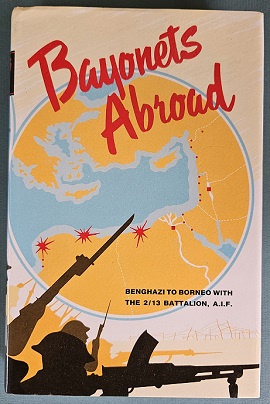Description
Title: Getting on with it – 2/30th Battalion AIF : A unique story of the soldiers who beat the odds
Author:
Condition: Very Good
Edition: 1st Edition
Publication Date: 1998
ISBN: 1875357041
Cover: Soft Cover without Dust Jacket – 52 pages
Comments: A pictorial history of the 2/30th Infantry Battalion as seen through the eyes of it’s soldiers and includes their stories.
The 2/30th Infantry Battalion was formed on 22 November 1940 at Tamworth in New South Wales. It did its initial training at the Tamworth showgrounds, before moving to Dubbo, Goulburn, North Sydney, Randwick, Wallgrove, and Wagga Wagga. The first 2/30th commander, Lieutenant Colonel F.G. “Black Jack” Galleghan, trained the men hard and they became know as “Galleghan’s greyhounds”.
The battalion was part of the 8th Division’s 27th Brigade, the last AIF infantry brigade raised for service during the Second World War. At the end of July 1941 the main component of the 2/30th sailed to Singapore on board the Dutch ship Johan Van Oldenbarnevelt, as part of the convey carrying the 27th Brigade. The battalion then went to Malaya and soon put what it had learnt into practice.
Just before midnight on 7 December, Japanese forces landed at Singora and Patani in Thailand, and Kota Bahru in northern Malaya. They fought against British and Indian troops, until the 2/30th B Company ambushed the Japanese at Gemencheh Bridge, shortly before 4 pm on 14 January 1942. The rest of the battalion, located 4 miles to the rear of this position (in front of Gemas, on the Gemas–Tampin road), engaged the Japanese the next day. It was a brilliant ambush and the first AIF attack against the Japanese. The 2/30th suffered 20 killed or missing believed dead and 58 wounded. The Japanese casualties were thought to be about 1,000. The battalion had fulfilled its task of acting “as a shock-absorber” and “inflict[ing] as many casualties as possible”, before falling back.
After Gemas, the 2/30th fought at Ayer Hitam and then in the defence of Singapore Island. However, they could not stop the Japanese and on 15 February the British commander on Singapore surrendered. The battalion spent the next three-and-a-half years as prisoners of war.
After the surrender the battalion was concentrated in Changi goal, where they were used as labour for work parties, first in Singapore and then in other parts of Japan’s Greater East Asia Co-prosperity Sphere. Men were sent to work on the Burma–Thailand railway, Borneo, and Japan. Over three hundred men from the 2/30th died during captivity.
A lucky few, however, were spared the ordeal. Prior to Percival’s surrender, 44 men who had been sick, injured, or wounded, were repatriated to Australia. A few others escaped and managed to make their way back to Australia. But there was no attempt to reform the battalion.
The war finally came to an end in August 1945 and Japan signed the official surrender the following month. Yet due to the large number of Allied prisoners who needed to be repatriated, it took some time for the battalion survivors to return to Australia. Those in need of urgent medical care were flown back to Australia in varying aircraft, including Dakotas, Catalinas, and converted Liberator bombers. The majority returned to Sydney in October on board the Esperance Bay.





